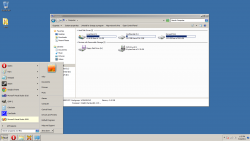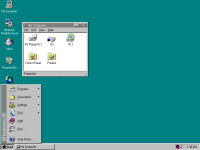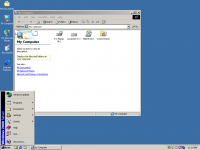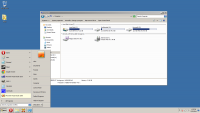 |
|
| Classic on Windows 7 RTM. | |
| Caption buttons | |
| Taskbar | |
 |
|
| Notification area | |
| First seen | Chicago 4.00.81 |
|---|---|
| Last seen | Windows 7 (7601) |
"Windows Classic" is the name of the grey and blue style that has been in Windows since the release of Windows 95. It was the default theme on all versions of Microsoft Windows prior to Windows XP. There are several versions of this theme, as it was modified several times troughout Windows development.
Windows 95, NT 4.0 and 98
Windows 95 was the first to introduce the Classic theme. Some minor changes were made in Windows NT 4.0, most notable being the new start menu graphic (a blue-black gradient instead of only grey).
Windows 98 also included some minor changes: the new gradient title bar, web-based folder view graphics and updated icons.
Windows 2000 and Millennium Edition
In Windows 2000 Beta 3 another update to the theme was made. Grey and blue colors were made lighter, the default background color was changed from green to blue, the default screen font was changed from MS Sans Serif to Tahoma and some icons were further modified. This new theme (now named "Standard") was also included in Windows Millennium Edition Beta 2 Refresh (build 2452) and onwards. The previous style, now available as "Classic" was also available.
Windows XP and Windows Server
Early XP builds up to 2257 still had Standard set as the default theme on first boot. Build 2250 also first included a slightly modified version that would later evolve into "Watercolor" (set as default from build 2257 onwards). Watercolor also included a new start menu, but the old one was now still available as part of the Classic and Standard themes. Build 2428 introduced a new default theme named "Luna" that was a direct replacement for Watercolor and Classic (which was still available). The start menu was updated as well. The previous 9X icon set was replaced by a new one (though individual old-sytle icons are still included), which was added into the Classic and Standard themes.
Windows Server 2003, unlike it's consumer counterpart XP, still had Standard as the default theme due to stability reasons (a tradition that would be kept up to this day). Users were also able to choose Luna and other themes.
Windows Vista and 7
The Classic version was included until Windows Vista, which shipped with Standard only. A new start menu graphic can be seen, as well as combinations with the new UI (icons, Aero window design, etc.). Windows Server 2008 and 2008 R2 also have Standard set as default instead of Aero.
Further changes were made in Windows 7, as the classic start menu that was once part of the theme since XP was removed and the Standard version was renamed to Classic for some reason.
The future
With Windows 8, the Windows Classic style was removed (along with Windows Basic) and was replaced with Aero Lite.


